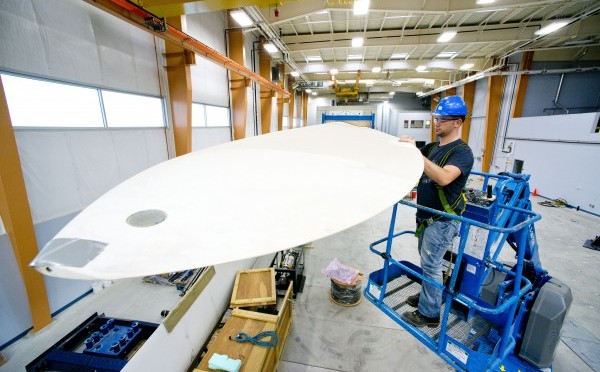You may have noticed the wind turbine that suddenly appeared last semester. As it turns out, it is all part of a larger plan for offshore wind energy here in Maine.
Habib Dagher, the director of the Advanced Structures and Composites Center, is busy planning the first phase of a “potential $93.2 million deepwater offshore wind demonstration project by the U.S. Department of Energy,” as described in a press release on their website.
The DOE held a competition to screen proposals for clean energy that would jumpstart wind farms in the United States. Seventy competitors submitted proposals for a chance to receive funding for their development of offshore wind energy.
The UMaine Composites Center team won the first phase of funding, which will grant the Composite Center up to $4 million to complete the engineering and design of the project.
After the first phase the DOE will select up to three projects to receive follow-up funding to further develop the project to construct a final product.
Advanced Structures and Composites Center received up to $4 million in engineering grant to fund wind turbine project.
Dagher has high hopes and aims to have two floating offshore wind turbines off of Monhegan Island by 2017. Dagher suggests that if UMaine is granted the next round of funding it will create jobs in Maine.
“It would make Maine a hub for offshore wind energy,” Dagher said, in regard to the potential for people and businesses around the world to come to Maine for these resources.
“People are paying attention to Maine now,” Dagher added.
Dagher has high hopes for the team and the state. The funding of the first phase could bring an industry of offshore wind energy to the state, creating jobs and making Maine the center of attention for clean energy.
“The University needs to be thought leaders,” Dagher said.
The testing, designing and engineering of models occurs around the clock at the Composite Center here on campus to ensure the project’s success.
This testing must happen before the big turbines are thrown into the ocean. The final product is projected to stand 300 feet tall, from the water level to the hub, and 425 feet in rotor diameter.
A 1-50 scale of the model turbine was made and tested in multiple “perfect storm” scenarios.
Currently, a 1-8 scale model is being tested on campus behind the Composite Center. Tests are being run for remote communications between progress of the wind energy and feeding those results back to the lab.
The turbine seen on campus will eventually be put in the water for further testing.
Dagher is excited for a final product to go into the water because it will be “the first offshore wind turbine in the United States and the first floating turbine,” he said.
Floating turbines might not seem any more revolutionary than those that are fixed into the seabed, but Dagher ensures there are more benefits than what meets the eye.
“Floating wind turbines can be prefabricated, dock side, which cuts cost,” Dagher described, noting it takes a 20-ton tugboat to take it out to sea.
“Wind is better, further out to sea,” Dagher commented. “[When a turbine is placed] over 20 miles offshore, you get 30 percent more energy produced per turbine,” he added.
The floating turbines offer flexibility in where you place the farms as well. “You can stay out of environmentally sensitive areas,” Dagher added.
Another factor that Mainers will be happy about is placing turbines so far out you cannot see them: “The landscape does not change,” Dagher said.
“There is enough wind energy within 50 miles of our shores to power the United States, four times over,” Dagher commented. The only challenge is how can the U.S. harness that energy in a cost-effective way.
Dagher broke down the numbers to explain the state’s potential. One gigawatt is roughly equal to the power produced by one power plant. Wind energy from Maine’s coast alone could potentially generate 156 gigawatts.
With so much potential for clean, renewable energy, Dagher hopes to help reduce reliance on fossil fuels. “If we invest in our own resources, the money stays in Maine,” he said. “There is a huge resource off our coasts.”
The floating design for the offshore wind turbines, called “VolturnUS,” is currently in the process of obtaining a patent. Students who work in the lab came up with the name, whichincludes the words “volt,” “turn” and “U.S.”
By Lauren Reeves, http://mainecampus.com/



